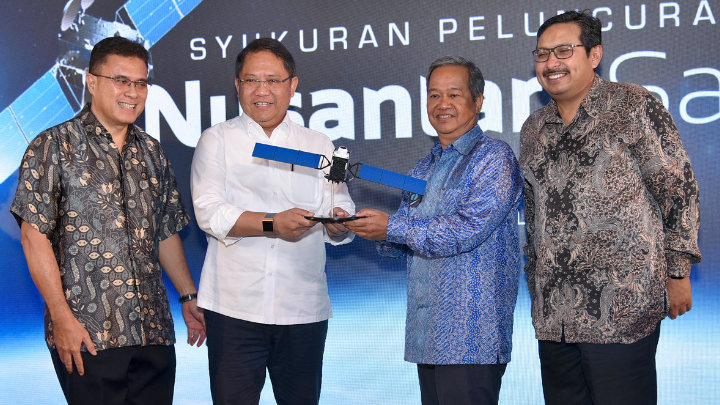JAKARTA, April 1, 2019 – The Nusantara Satu Satellite owned by PT Pasifik Satelit Nusantara (PSN), the first private satellite-based telecommunications company in Indonesia, is ready to serve internet needs throughout Indonesia after successfully launching on Friday, February 22, 2019, at 8:45 WIB from Cape Canaveral, Florida, United States. After conducting in-orbit raising, on March 7, Nusantara Satu successfully orbited at 146° East or right above Papua according to schedule. Currently, Nusantara Satu is conducting the final in-orbit test and technical indications show that the satellite is in normal condition according to its specifications.
As a form of gratitude for the success of the Nusantara Satu Satellite in orbit according to schedule, PSN held a Nusantara Satu Launch Thanksgiving which was held at the Shangri-La Hotel Jakarta, Monday (1/4). The event was attended by the Minister of Communication and Information (Menkominfo) Rudiantara and all Directors, management, and employees of PSN also participated.
PSN President Director Adi Rahman Adiwoso said, after orbiting and conducting a series of tests, Nusantara Satu was declared in a healthy condition or all technical specifications were met according to the design and expectations.
“With the spirit of ‘Unite Indonesia’, the Nusantara Satu Satellite has carried out its duties well until now and is ready to operate in order to provide equal internet access to all Indonesian people. This is in line with PSN’s commitment and consistency to continue to encourage the use of satellites to reduce the digital gap throughout Indonesia,” said Adi during the Nusantara Satu Launch Thanksgiving event at the Shangri-La Hotel, Jakarta, Monday (1/4).
According to Adi, a series of tests have been carried out by Nusantara Satu. The day after orbit or on March 8, 2019, the in-orbit test or In Orbit Test (IOT) was carried out, namely in Cikarang carrying out the Payload/Transponder IOT, while the Bus IOT was carried out at the Mission Control Center (MCC) Palo Alto from SSL. In addition, the PSN team also conducted verification from the Satellite Control Facility (SCF) in Jatiluhur, Purwakarta, West Java.
Satellite control, said Adi, since it was launched until it reached orbit, Nusantara Satu was still controlled by SSL’s MCC Palo Alto, but remained under the supervision of SCF Jatiluhur. After a series of tests on the satellite ran smoothly and the administrative process was completed, SSL will hand it over to PSN no later than April 1.
“Everything under our control such as the network monitoring center in Cikarang and SCF Jatiluhur has been ready to operate since November 2 last year. We are grateful that the launch of the satellite until it reached its orbit and the implementation of the entire process from preparation, launch, journey to orbit to a series of technical tests have been carried out well,” said Adi.
The Nusantara Satu satellite is the first broadband satellite in Indonesia with High Throughput Satellite (HTS) technology which can provide internet services with a larger capacity than conventional satellites. In addition, the Next Generation Electric Propulsion technology on the Nusantara Satu Satellite is able to make the satellite very light during launch, making it more efficient and cost effective, making investment costs more affordable.
When launched, the Nusantara Satu Satellite only weighs four tons, while Space-X’s cargo capacity is seven tons. On its journey, the Nusantara Satu Satellite released Forecone and the SSV2 Satellite at an altitude of around Geosynchronous. Then the Nusantara Satu Satellite successfully occupied orbit on Thursday, March 7, 2019 and immediately carried out a series of test trials.
The Nusantara Satu Project Leader who also serves as the Director of Planning and Development of PSN, Dani Indra Widjanarko, explained that the IOT test on the Nusantara Satu Satellite needed to be carried out to evaluate the health of the satellite after launch. The test went well without any degradation of technical specifications or reduction in the satellite’s lifespan. From launch to the journey to orbit, everything went according to schedule without any anomalies.
After reaching orbit, the Nusantara Satu Satellite was first checked for the Bus and Payload/Transponder before starting operations. “A series of critical tests that were carried out have been completed and all technical specifications have also been met according to the design. The Bus and Transponder checks showed good results. Various other test procedures were also successfully passed according to predictions. In fact, in many cases, the results exceeded our expectations,” said Dani.
The Nusantara Satu Satellite has a capacity of 26 C-band transponders and 12 Extended C-band transponders and 8 Ku-band spot beams with a total bandwidth capacity of 15 Gbps. The satellite’s C-band and Extended C-band coverage covers Southeast Asia, while Ku-Band covers the entire territory of Indonesia consisting of 8 Spot Beams on the HTS system. By using the SSL-1300 140 platform, the Nusantara Satu Satellite is capable of orbiting and operating for more than 15 years.
Adi added that the operation of the Nusantara Satu Satellite is expected to overcome the internet gap that occurs. Currently, around 3 thousand villages have been successfully connected by PSN, by the end of 2019 the number is targeted to increase to 10 thousand villages. And it is estimated that 25 thousand villages can be connected to the internet around 2020-2021.
“We are sure that the capabilities of the Nusantara Satu Satellite can open wider access to information technology, especially for people in various remote areas so that they can open up opportunities for accelerating the economy in the regions. This is a form of PSN’s commitment and contribution in building communication infrastructure for the Indonesian people towards a more advanced and prosperous Indonesia,” concluded Adi.



